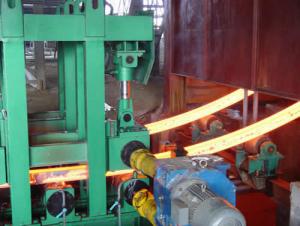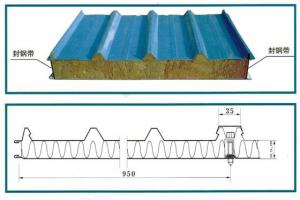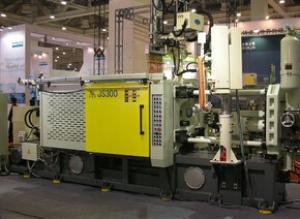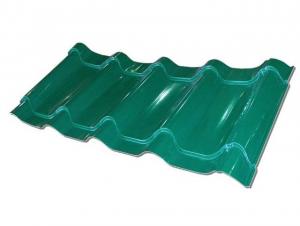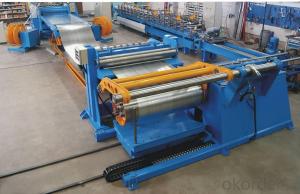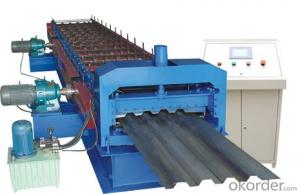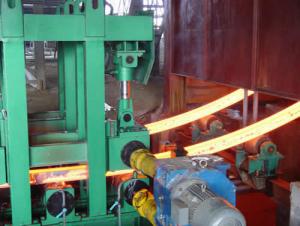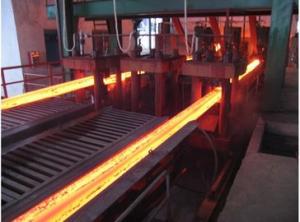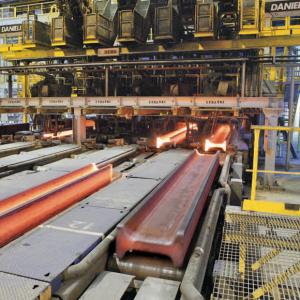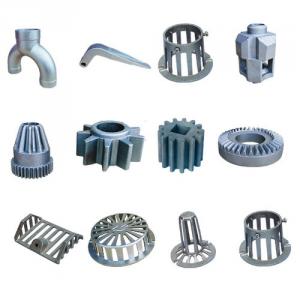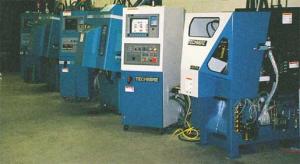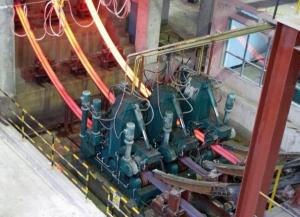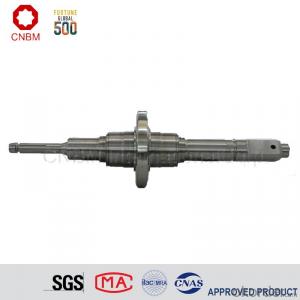Steel Continuous Casting Machine
- Loading Port:
- China Main Port
- Payment Terms:
- TT or LC
- Min Order Qty:
- 1 Set set
- Supply Capability:
- 30 Sets Per Year set/month
OKorder Service Pledge
Quality Product, Order Online Tracking, Timely Delivery
OKorder Financial Service
Credit Rating, Credit Services, Credit Purchasing
You Might Also Like
Technology process:
1.Heat the EVA film
2.Cover the heated EVA film on the mould(can be made from wood or aluminum)
3.Spray a coating in a certain baume degree
4.Put on the empty blask
5.Sand-up the flask and vibrate to compaction
Packaging & Delivery
Packaging Details:containers
Delivery Detail:Complete one set of equipment needs for three months
- Q: What are the different types of cores used in sand casting with metal casting machinery?
- The different types of cores used in sand casting with metal casting machinery include green sand cores, dry sand cores, shell cores, and cold box cores.
- Q: Can metal casting machinery be used for producing castings with good corrosion resistance?
- Yes, metal casting machinery can be used for producing castings with good corrosion resistance. Specialized alloys and coatings can be used in the casting process to enhance the corrosion resistance of the final product. Additionally, the quality of the casting process, including proper material selection, design, and manufacturing techniques, can also contribute to achieving good corrosion resistance in castings.
- Q: Can metal casting machinery be used for investment casting of cobalt-based alloys?
- Metal casting machinery is capable of being used for investment casting of cobalt-based alloys. Investment casting, also referred to as lost-wax casting, is a flexible method that can produce intricate and complex shapes in various materials, including cobalt-based alloys. To manufacture top-quality castings of cobalt-based alloys through the investment casting process, metal casting machinery like furnaces, wax injection systems, and ceramic shell coating equipment can be employed. These machines enable precise control of temperature, pressure, and other factors to guarantee the desired casting properties and dimensional accuracy. However, it is worth noting that cobalt-based alloys possess unique characteristics, which may call for specific considerations during the investment casting process, such as the utilization of specialized refractory materials or adjustments to the casting parameters. Therefore, seeking guidance from experts or manufacturers experienced in casting cobalt-based alloys is recommended to ensure optimal outcomes.
- Q: What safety precautions should be taken when operating metal casting machinery?
- When operating metal casting machinery, it is crucial to follow strict safety precautions to protect oneself and others from potential hazards. Here are some important safety measures that should be taken: 1. Familiarize yourself with the machinery: Before using any metal casting equipment, thoroughly read and understand the manufacturer's instructions and guidelines. This will help you become familiar with the specific safety features and operational procedures of the machinery. 2. Personal protective equipment (PPE): Always wear appropriate PPE such as safety glasses, face shields, gloves, and protective clothing when operating metal casting machinery. These items help protect against molten metal splashes, hot surfaces, and potential burns. 3. Adequate training: Ensure that all operators are adequately trained to use the metal casting machinery. This should include training on proper handling techniques, emergency procedures, and understanding potential risks associated with the equipment. 4. Regular maintenance and inspections: Regularly inspect the machinery for any signs of wear, damage, or malfunctions. This includes checking electrical connections, hydraulic systems, and ensuring all safety guards and interlocks are in place and working correctly. 5. Secure work area: Maintain a clean and organized work area, free from any obstacles and clutter. Ensure that the metal casting machinery is stable, properly anchored, and situated on a level surface to prevent accidental tipping or falling. 6. Lockout/tagout procedures: Implement lockout/tagout procedures to ensure the machinery is de-energized and cannot be started or operated during maintenance or repair work. This prevents accidental start-ups that could potentially cause serious injuries. 7. Fire prevention: Install and maintain appropriate fire prevention measures, including fire extinguishers, fire blankets, and proper storage of flammable materials. Regularly inspect electrical connections and wiring to prevent potential fire hazards. 8. Proper ventilation: Ensure that the work area is well-ventilated to minimize exposure to harmful fumes, gases, or dust generated during metal casting operations. Use local exhaust ventilation systems or wear appropriate respiratory protection when necessary. 9. Emergency preparedness: Familiarize yourself with emergency procedures, including how to shut off power to the machinery and the location of emergency exits and first aid kits. Regularly conduct drills to ensure all operators are aware of the correct actions to take in case of an emergency. 10. Continuous supervision: Always have a designated supervisor or competent person present when metal casting machinery is in operation. This person should be responsible for monitoring the operation, enforcing safety protocols, and addressing any potential safety concerns. By following these safety precautions, operators can significantly reduce the risk of accidents and injuries when operating metal casting machinery. It is important to prioritize safety at all times to create a secure working environment.
- Q: What are the common defects that can occur in centrifugal casting using metal casting machinery?
- There are several common defects that can occur in centrifugal casting using metal casting machinery. These defects can affect the quality and integrity of the final castings. Some of the most common defects include: 1. Porosity: Porosity refers to the presence of small voids or cavities in the castings. This defect can occur due to the presence of gases, improper venting, or inadequate mold filling. Porosity can weaken the castings and make them more susceptible to failure. 2. Inclusions: Inclusions are foreign materials such as sand, slag, or oxides that get trapped in the casting during the pouring process. These inclusions can cause weak spots or discontinuities in the castings, leading to reduced strength and performance. 3. Shrinkage: Shrinkage occurs when the casting cools and solidifies, resulting in a reduction in volume. This can cause internal voids, cracks, or distortion in the casting. Proper gating and risering systems can help minimize shrinkage defects. 4. Cold shuts: Cold shuts are defects that occur when two streams of metal fail to fuse properly during the casting process. This can lead to weak joints and potential failure under stress. Cold shuts are typically caused by inadequate pouring techniques or improper gating design. 5. Misrun: A misrun defect occurs when the molten metal fails to completely fill the mold cavity, resulting in an incomplete casting. This can lead to weak sections or missing features in the final product. Misruns can be caused by improper mold design, insufficient pouring temperature, or inadequate metal flow. 6. Warpage: Warpage refers to the deformation or distortion of the casting after solidification. It can occur due to uneven cooling or improper mold design. Warpage can affect the dimensional accuracy and functionality of the casting. 7. Surface defects: Various surface defects can occur in centrifugal castings, including rough surfaces, cracks, or scale formation. These defects can be caused by inadequate mold preparation, improper mold release agents, or excessive mold temperature. To minimize these defects, proper process control, including optimal pouring temperature, adequate mold preparation, and proper gating and risering design, is essential. Regular inspection and quality control measures can also help identify and rectify any defects before they affect the final product.
- Q: How are gating and risering systems designed in metal casting machinery?
- Gating and risering systems in metal casting machinery are designed to ensure proper flow of molten metal into the mold cavity and to compensate for shrinkage during solidification. The gating system consists of channels and passages that guide the metal from the pouring basin into the mold, while the risering system includes vertical channels (risers) that provide additional molten metal to compensate for shrinkage and promote proper filling of the mold. These systems are designed based on factors such as the type of metal being cast, the shape and size of the casting, and the desired quality and integrity of the final product. Various techniques such as computer simulations, experience-based knowledge, and trial-and-error methods are employed to optimize the design of gating and risering systems for efficient and defect-free metal castings.
- Q: What are the different types of training and certification programs available for operators of metal casting machinery?
- There are several different types of training and certification programs available for operators of metal casting machinery. These programs are designed to provide individuals with the necessary knowledge and skills to safely and effectively operate various types of metal casting equipment. One common type of training program is offered by equipment manufacturers. These programs typically focus on the specific machinery produced by the manufacturer and provide in-depth training on its operation, maintenance, and troubleshooting. Participants in these programs usually receive a certificate of completion, indicating their proficiency in operating that particular equipment. In addition to manufacturer-specific programs, there are also industry-wide certification programs available. These programs are typically offered by trade associations or professional organizations within the metal casting industry. They cover a broader range of equipment and processes and aim to ensure that operators possess a standardized level of knowledge and skills. These certifications often require passing a written exam and demonstrating practical skills in operating metal casting machinery. Furthermore, there are vocational schools and technical institutes that offer comprehensive training programs for aspiring metal casting machinery operators. These programs typically provide a combination of classroom instruction and hands-on training, covering a wide range of casting processes, equipment operation, safety protocols, and quality control procedures. Upon completion of these programs, graduates may receive a diploma or an associate degree. Lastly, some companies may provide in-house training programs for their employees who operate metal casting machinery. These programs are tailored to the specific needs and requirements of the company and may focus on equipment operation, safety procedures, and quality control measures specific to their operations. Overall, operators of metal casting machinery have a variety of training and certification options available to them. Whether through manufacturer-specific programs, industry-wide certifications, vocational schools, or in-house training, individuals can acquire the necessary knowledge and skills to become proficient operators of metal casting machinery.
- Q: What are the different types of machining operations performed on castings using metal casting machinery?
- There are several different types of machining operations that can be performed on castings using metal casting machinery. These operations are essential for achieving the desired shape, size, and surface quality of the final product. Some of the most common machining operations performed on castings include: 1. Turning: This operation involves rotating the casting against a cutting tool to remove excess material and create a cylindrical shape. Turning is typically used to produce round or cylindrical components like shafts or sleeves. 2. Milling: Milling is the process of using rotary cutters to remove material from the casting, resulting in a flat or contoured surface. It is commonly used to create slots, grooves, or complex shapes on the casting. 3. Drilling: Drilling involves creating holes in the casting using a rotating cutting tool. It is used to add holes for fasteners, create openings for fluid flow, or enable the installation of additional components. 4. Grinding: Grinding is a machining operation that uses abrasive wheels to remove material and achieve a smooth surface finish. It is commonly employed to remove surface defects, burrs, or sharp edges from the casting. 5. Tapping: Tapping is the process of creating internal threads in a casting. It involves using a cutting tool to create threads inside a pre-drilled hole. Tapping is often used to create threaded holes for fasteners or connectors. 6. Boring: Boring is a machining operation used to enlarge existing holes in a casting. It is often performed with a single-point cutting tool to achieve accurate dimensions and precise alignment. 7. Sanding and Polishing: Sanding and polishing operations are performed to improve the surface finish and remove any remaining imperfections on the casting. These operations use abrasive materials or polishing compounds to achieve a desired smoothness or shine. It is important to note that the specific machining operations performed on castings can vary depending on the complexity of the part, the material being machined, and the desired final product requirements.
- Q: How is the casting removed from the mold in metal casting machinery?
- In metal casting machinery, there are several methods for removing the casting from the mold. One common method is called shakeout, where the mold is vibrated or shaken to loosen the casting. This process helps to break the bond between the casting and the mold material, allowing for easier removal. Another method is called knockout, which involves using mechanical force to knock the casting out of the mold. This can be done using hammers, mallets, or pressurized air. The force applied helps to dislodge the casting from the mold cavity. In some cases, the mold may be designed to have removable sections or parts known as cores. These cores are usually made from sand or metal and are used to create complex shapes or internal cavities in the casting. Once the casting has solidified, the cores are removed by either pulling them out or using various techniques like water pressure, air pressure, or mechanical devices. Additionally, in certain metal casting processes such as investment casting or lost wax casting, the mold is made from a material that can be easily broken or dissolved. After the casting has solidified, the mold is destroyed, either manually or through chemical means, to release the casting. Overall, the method of removing the casting from the mold in metal casting machinery depends on the specific casting process being used and the complexity of the mold design. The goal is to safely and efficiently separate the casting from the mold while minimizing any damage to the finished product.
- Q: How is the surface finish of the casting improved in metal casting machinery?
- Various methods and techniques can be utilized in metal casting machinery to enhance the surface finish of the casting. One commonly employed technique is the utilization of sandblasting or shot blasting. This entails forcefully propelling abrasive particles, such as sand or steel shot, onto the casting's surface at high speed. The impact of these particles eliminates any surface imperfections, including rough spots, scale, or oxidation, resulting in a more polished and refined surface finish. Another approach involves the implementation of a well-designed gating and risering system. The gating system pertains to the arrangement of channels and gates through which molten metal flows into the mold cavity. A meticulously planned gating system ensures a consistent and uniform flow of metal, minimizing turbulence and reducing the occurrence of defects. Similarly, the risering system involves the use of risers or feeders to provide a continuous supply of molten metal to compensate for shrinkage during solidification. This aids in achieving a more uniform cooling and solidification process, leading to an improved surface finish. Moreover, specialized coatings can also enhance the surface finish of castings. These coatings can be applied to either the mold cavity or the casting's surface itself. They create a barrier between the molten metal and the mold, preventing the formation of defects like mold sticking or metal penetration. Additionally, they contribute to a smoother surface texture, enhancing the overall appearance of the casting. Lastly, the choice of appropriate molding materials and processes significantly impacts the surface finish of castings. For instance, the use of high-quality molding sand or the application of advanced molding techniques such as vacuum casting or pressure casting can aid in achieving a finer and more refined surface finish. In conclusion, improving the surface finish of castings in metal casting machinery involves employing techniques like sandblasting, implementing well-designed gating and risering systems, using specialized coatings, and carefully selecting molding materials and processes. By incorporating these methods, manufacturers can produce castings with a smoother and more aesthetically pleasing surface finish.
Our professions include metallurgical technology, equipment and automation. We can provide the best solutions to the production process, design & manufacture of equipment and electrical automation regarding various industries in domestic and foreign districts with exquisite technology and fine quality service. We can provide all-around services to customers from development & design to the provision, installation and running of products.Strong technical strength, advanced equipment manufacturing technology, fine quality professional talents, and perfect service systems all bring about reliability, relaxation, convenience and delight to the cooperation with customers from beginning to end.
1. Manufacturer Overview
| Location | Jiangsu,China (Mainland) |
| Year Established | 2000 |
| Annual Output Value | |
| Main Markets | South America Eastern Europe Southeast Asia Africa Mid East South Asia Domestic Market |
| Company Certifications |
2. Manufacturer Certificates
| a) Certification Name | |
| Range | |
| Reference | |
| Validity Period |
3. Manufacturer Capability
| a) Trade Capacity | |
| Nearest Port | SHANGHAI |
| Export Percentage | 21% - 30% |
| No.of Employees in Trade Department | 3-5 People |
| Language Spoken: | English, Chinese |
| b) Factory Information | |
| Factory Size: | |
| No. of Production Lines | |
| Contract Manufacturing | |
| Product Price Range | |
Send your message to us
Steel Continuous Casting Machine
- Loading Port:
- China Main Port
- Payment Terms:
- TT or LC
- Min Order Qty:
- 1 Set set
- Supply Capability:
- 30 Sets Per Year set/month
OKorder Service Pledge
Quality Product, Order Online Tracking, Timely Delivery
OKorder Financial Service
Credit Rating, Credit Services, Credit Purchasing
Similar products
Hot products
Hot Searches
Related keywords
